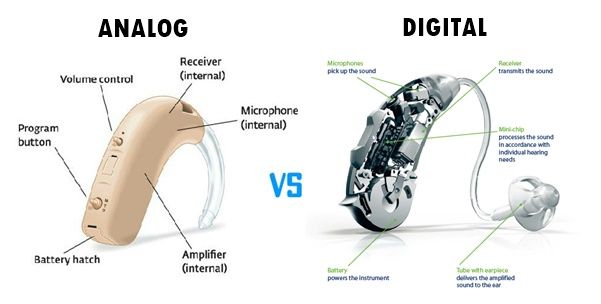Types of Hearing Aids – ANALOG Vs DIGITAL HEARING AID
Analog and digital hearing aids both help you recover your hearing, but they work in very different ways. Which one is the right choice for you?
Modern hearing aid technology is very different from what was in use even just a decade ago. One of the biggest changes is the rise of digital hearing aids as an alternative to older analog devices. Whether you’re new to wearing hearing aids or you’re a longtime user thinking about a new model, you should know about the ways hearing aids differ and the advantages of each type.

ANALOG HEARING AIDS
For many years, analog hearing aids were the only kind you could get. Today, analog devices are still available and offer a number of benefits for users.
Analog hearing aids work in a similar way to a microphone hooked up to a speaker. The hearing aid picks up outside sound, amplifies it, and outputs the same sound at a louder volume. Unlike digital hearing aids, analog hearing aids amplify all sound equally. They aren’t able to separate foreground and background noise or isolate certain types of sound.
That said, many analog hearing aids are still programmable, and even offer multiple listening modes for different environments. Some people also think analog hearing aids sound “warmer” because the sound isn’t digitally processed.
Other advantages of analog hearing aids include:
• Lower prices on average
• Longer battery life at the same output volume
• Easier to set up
DIGITAL HEARING AIDS
Most modern hearing aids are digital hearing aids. Digital hearing aids work by passing sound through a DSP, or Digital Signal Processor. This is a tiny computer chip which can read sound waves and process or manipulate them in many ways. Digital hearing aids offer many advanced capabilities and benefits that aren’t possible with analog technology.
If an analog hearing aid is like a microphone and a speaker, a digital hearing aid is more like a computer. It still takes in and puts out the sound, but in between, it can do some amazing things. Digital hearing aids can amplify or eliminate frequencies and noise patterns and even shift sounds to more comfortable ranges. They can also interact with computers, phones, and many other devices.
Digital hearing aids offer some other advantages too, like:
• Multiple listening modes for different environments or circumstances
• More adaptable to your specific listening needs
• Less prone to feedback, such as whistling or whining
• Usually smaller and lighter than analog hearing aids
• Constantly monitor your environment to automatically determine the best sound quality
• Wireless/Blue tooth connectivity options are also available in digital hearing aids.
• Rechargeable ric also comes under digital hearing aids
WHICH ONE IS RIGHT FOR YOU?
If you aren’t sure whether analog or digital hearing aids are better for your hearing needs, talk to your audiologist about it today. He or she can help you decide on a model that fits your needs and your budget.
